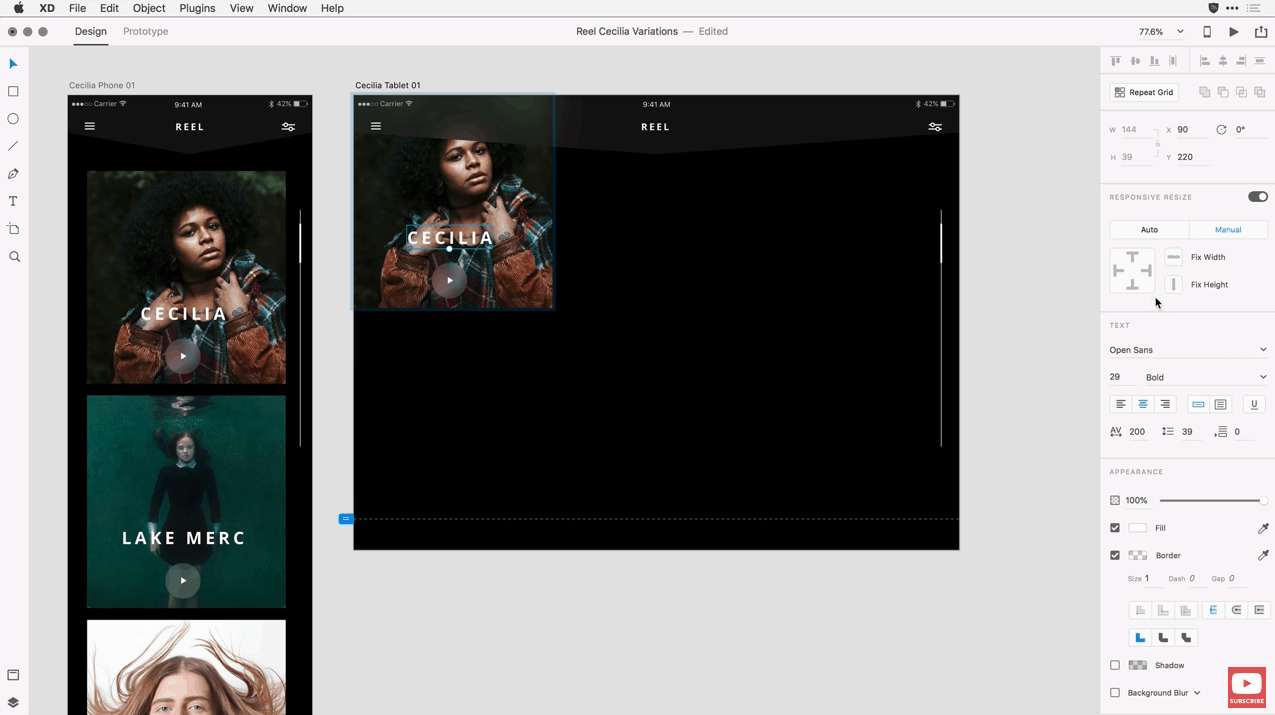

- XD RESPONSIVE RESIZE HOW TO
- XD RESPONSIVE RESIZE PRO
- XD RESPONSIVE RESIZE CODE
- XD RESPONSIVE RESIZE PROFESSIONAL
Finally, I'll change the color of this text to white, so it stands out against my black navigation bar. I also want this to be heavy to add a bit of emphasis. I'll change our font to Avenir, and I'll make the size 20. The good news is that the background color for these textboxes is already transparent, so I don't need to change that, but I do need to change a few of the things using the Property Inspector here. I'll click the textboxes while holding the Shift key until all six textboxes are selected. Now I need to change the look and feel of all this text in the navigation bar. Then I'll add textboxes for Account and Basket to the right side of the nav bar. Similar to my wireframes, I'll add textboxes for Search, Discover, Donate, and About to the left side of the nav bar next to the logo. I need to add more text into the nav bar for the links to other pages. Let me keep building this part of the page out. Using hex codes instead of randomly picking a color allows me to make sure that I'm using the same color throughout my mockup.
XD RESPONSIVE RESIZE CODE
Finally, I'll adjust the color to a mustard yellow using hex code E0D15C. Next, I'll change the font to Bely Display and make the size 48. I'm going to create a textbox and type in WCL, which stands for Wisconsin County Library. For my mockup, I don't need to drop in an image though, because my logo is just simple text.
XD RESPONSIVE RESIZE PRO
Here's a quick pro tip: Adobe XD lets you add images really easily by creating a rectangle first and then dropping the image inside of it. Next, I add the logo to the far left side of the navigation bar. I'll set the background color of the navigation bar to black by clicking the "fill" option and "draw appearance" in the Property Inspector. I'll draw a rectangle for the background. I personally prefer to work from the top of the page down, but you can design your pages in any order you like. Now I'll move this second artboard below the first one so it's easy for me to track the flow of my work. This makes it a little easier to refer to the wireframe when I'm making the mock. So I'll pop over to the toolbar and I'll pick the artboard tool and add a "web 1920" artboard directly below the homepage wireframe. Because my wireframes are all neatly lined up, I'm going to create a new artboard below the wireframe that I'll be using for reference, which is the homepage in this case. It's always a good idea to have the wireframes in front of you as you create mockups. First, I'll open Adobe XD and select the artboard that has the wireframe of the library website homepage on it. I'll go through steps to create a mockup from my library website homepage based on the wireframes I created earlier in the course.

It's time to start using what you've learned to create your own mockup in Adobe XD. No previous experience with Adobe XD is required. Alternatively, learners need to have a strong foundational understanding of the design process experience creating wireframes, mockups, and prototypes and the ability to conduct usability studies. This course is suitable for beginner-level UX designers who have completed the previous five courses of the Google UX Design Certificate.

XD RESPONSIVE RESIZE HOW TO
Learn how to search for and apply to introductory-level jobs in the field of UX.
XD RESPONSIVE RESIZE PROFESSIONAL
Add a new design project to your professional UX portfolio. Iterate on designs based on research insights. Plan and conduct a usability study to gather feedback about designs. Plan information architecture and create sitemaps for website designs. Develop designs in a popular design tool, Adobe XD. Apply each step of the UX design process (empathize, define, ideate, prototype, test) to create a responsive website. Learners who complete the seven courses in this certificate program should be equipped to apply for entry-level jobs as UX designers.īy the end of this course, you will be able to: In addition, you’ll learn how to search for entry-level UX design jobs, create a resume that highlights your skills and accomplishments, and build your professional portfolio website.Ĭurrent UX designers and researchers at Google will serve as your instructors, and you will complete hands-on activities that simulate real-world UX design scenarios. By the end of this course, you will have a new design project to include in your professional UX portfolio. You will complete the design process from beginning to end: empathizing with users, defining their pain points, coming up with ideas for design solutions, creating wireframes and prototypes, and testing designs to get feedback. In this course, you will design a responsive website using Adobe XD, a popular design tool. Responsive Web Design in Adobe XD is the sixth course in a program that will equip you with the skills you need to apply to entry-level jobs in user experience (UX) design.


 0 kommentar(er)
0 kommentar(er)
